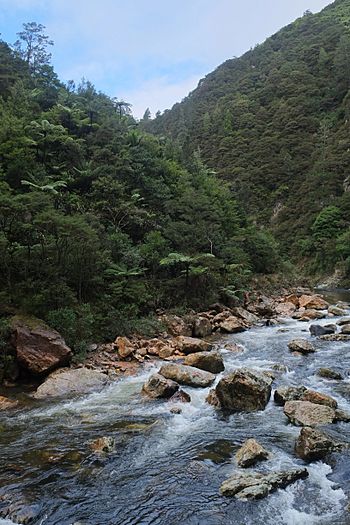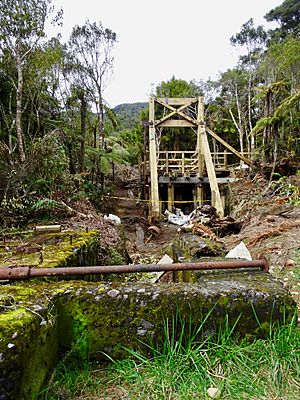Waitawheta River facts for kids
Quick facts for kids Waitawheta River |
|
|---|---|

Waitawheta River at Waitawheta Gorge
|
|
| Country | New Zealand |
| Physical characteristics | |
| Main source | Kaimai Range |
| River mouth | Ohinemuri River 38 metres (125 ft) |
| Length | 17 kilometres (11 mi) |
The Waitawheta River is a cool river in the Waikato Region of New Zealand's North Island. It starts near Mount Te Aroha in the Kaimai Range. The river then flows to the Karangahake Gorge. It joins the Ohinemuri River at Karangahake, which is about five kilometers east of Paeroa.
The river flows past a small town called Waitawheta. It then goes through the narrow Waitawheta Gorge. Finally, it reaches the famous Karangahake Gorge. From the Karangahake end, you can find amazing walking trails.
One popular path is the "Windows Walk." It takes you through old mining tunnels high up in the cliff. Another path is the Crown Tramway Track, partly carved into the rock. The Crown Track, also called the Waitawheta Pipeline Walk, goes deeper into the gorge. It leads to the Dickey Flat campsite, which you can also reach by road.
Contents
Exploring the River's Mining Past
The place where the Waitawheta River meets the Ohinemuri River was once a busy gold mining area. The strong flow of the Waitawheta River was used to power large machines called stamping batteries. These machines would crush rocks to get gold out.
Waste materials from the Talisman Mine were dumped into the gorge. This happened through special openings at the end of the mining tunnels. Today, you can explore some of these tunnels on the "Windows Walk." You can also see the Woodstock Underground Pumphouse. It is on the left side of the river, further inside the gorge.
You can still see parts of the old mining tram tracks. Only the foundations are left of the big stamping battery buildings. Around 1900, the Talisman mine was very active. It had 50 stampers and many buildings on both sides of the Waitawheta Gorge.
Discovering the River's Geology
The entire area around the Waitawheta River is part of the Coromandel Volcanic Zone. This means the land was formed by volcanoes. The river mainly flows over rocks that are millions of years old.
These rocks include andesite and dacite. They were formed from lava flows and other volcanic materials. Some rocks in the area have also been changed by hot water, making them rich in minerals.
Near the river, there is a place called Waitawheta Quarry. In 2008, this quarry produced a lot of andesite rock. This rock is used for building roads and other construction projects.
In 2017, some people protested against new mining plans. A company called New Talisman Gold Mines wanted to start mining again at the old Talisman site in Karangahake.
Wildlife Living in the River
A survey in 2015 looked at the animals living near the river. They found small snails called Potamopyrgus. They also found different types of eels, like Shortfin and Longfin eels. Other fish included Common bully and Banded kokopu.
You can also find Brown trout and freshwater crayfish called Koura. The river's health was rated "excellent" based on the types of insects found there. Before this survey, efforts were made to reduce the number of goats in the area. An old report from 1924 said that a shag bird colony was destroyed by sawmill workers. They wanted more trout in the river.
Logging History of the Valley
The lower part of the valley was used for gold mining. The upper part was used for cutting down trees. From 1898 to 1928, different companies logged the area. These included the Waihi Gold Mining Co, the Kauri Timber Co, and the Waitawheta Sawmilling Co.
They used a special tramway to move the logs. This tramway was about 19 km (12 mi) long. It had a narrow gauge of 825 mm (2.707 ft; 32.5 in). They used it to transport about 9 million feet of kauri logs. This is more than 2,000 trees!
Logging stopped in 1928 because almost all the trees were gone. The tramway was then taken apart. Since 2006, most of the 8 bridges over the river have been replaced. Now, there are suspension bridges for walkers along the remaining 14 km of the old tramway.
The Waitawheta Hut was moved in 2004. It is now at the site of the old Waitawheta Sawmill. This spot is just above a waterfall called the Toilet Bowl.
In 1913, a power line from Horahora to Waihi also went through the valley. This power line was removed for scrap metal during World War 2.


